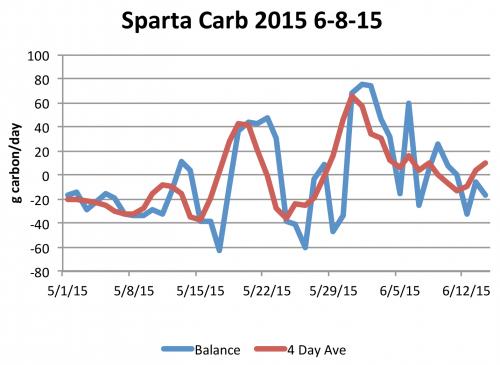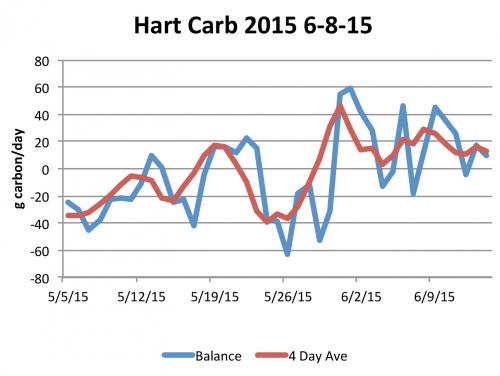West central Michigan tree fruit regional report – June 9, 2015
All tree fruits are setting very well despite poor weather during bloom
Apple thinning
Apples on the Ridge are mostly in the 18 to 24 millimeter stage. While there are some blocks and varieties that have poor set, the overall consensus is there are too many fruit left that didn’t get thinned as well as they should have. This was a difficult year for thinning with many unknowns, like potential winter injury and poor pollination weather. In many blocks, only the tops of trees need thinning.
For the Sparta and the Hart Carbohydrate Thinning Models, we are nearing the end of the thinning window for most varieties. For early varieties, we could be past our opportunity for chemical thinners to work any longer. The last Carbohydrate Thinning Model outputs indicate Sparta and Hart are at no stress to mild stress. If significant thinning is needed, use increased combination rates or consider Ethrel combinations.
The latest Carbohydrate Thinning Models are below. This will be the last run for the Sparta and Hart models for 2015.

The Carbohydrate Thinning Model for Sparta, Michigan, as of June 1, 2015.

The Carbohydrate Thinning Model for Hart, Michigan, as of June 1, 2015.
Growth stages from the MSU Clarksville Research Center as of June 8 as examined by Dan Platte, assistant farm manager:
Apples
- Empire – 22-26 millimeter green fruit
- Honeycrisp – 22-28 millimeter green fruit
- Jonagold – 22-26 millimeter green fruit
- Red Del – 20-24 millimeter green fruit
- Gala – 20-24 millimeter green fruit
Apricot – 1.25 inch diameter green fruit
Pluots – 1 inch diameter green fruit
Nectarines – 0.75 inch diameter green fruit
Peaches (variety unknown) – 0.75 inch diameter green fruit
Tree fruit diseases
Heavy rain was predicted for the last few days, but never really came to be. Light rains did release some ascospores and primary apple scab is still on. Spore numbers continue to decline, but full rates of fungicides are needed for the next possible infection event. All areas of west Michigan are now at 100 percent maturity for primary apple scab spores with a rain or two needed to be sure all are discharged.
Be on the lookout for fresh fire blight symptoms – all blossom blight should be showing by now. We see some newly planted trees are just coming into bloom and this could be a risk for infection with any rain events while bloom is open and viable.
Nectria twig blight is starting to show up in Rome blocks. This is a fungal disease that at first glance can be mistaken for fire blight shoot collapse.
We are seeing and hearing of powdery mildew in commercial apple blocks. The warmer and drier periods of weather this spring will favor mildew establishment. Scouts should be looking carefully for mildew.
Tree fruit insects
Black stem borer adults were first trapped May 8 and we continue to catch them in lower numbers. Trunk sprays should be already applied if you have sites with this sporadic pest.
There are continued reports of plum curculio egglaying. Activity has been slow, but steady with fresh egglaying scars still being found in all tree fruits. Plum curculio activity should be declining soon as fruits are getting too large for egg laying, about 20 millimeters for apples.
Codling moth first adult flight in high pressure blocks began May 16. First flight in low to moderate pressure blocks started 10 days later. Use an early biofix or problem blocks and later for all others A regional biofix was set for May 26 (357 GDD50 from Jan. 1); GDD50 since biofix is 184. Problem blocks are at 291 GDD since May 16 biofix. In high pressure blocks with an earlier biofix, egg hatch has begun and cover sprays are needed. In blocks with normal (low to moderate) pressure, early egg hatch will begin over the coming weekend for blocks that are over threshold for adult flight.
In some blocks with mating disruption and no adult trap catch in 1X lures, cover sprays are not necessary. If you feel compelled to add something for codling moth in low pressure blocks, consider including granulosis virus to your program – adding a quarter or half the rate will ensure codling moth remains a non-issue. For a great summary of codling moth management for 2015, please refer to “Codling moth back to normal in 2015.”
European red mite egg hatch continues in the west central region. All stages are now being found. Continue to monitor, especially in blocks with no petal fall miticides applied.
Many obliquebanded leafroller larvae are now in the pupal stage where controls will not have any effect. Adult flight is just beginning in the Grand Rapids area, but not enough to set a biofix just yet. Traps should be set.
Spotted tentiform leafminer second generation adults are beginning to fly. This minor pest seems to be very low in number this year.
White apple leafhopper new nymphs seem to be much easier to find this week compared to last, but overall numbers are low. We are approaching peak egg hatch this week. There continues to be adult potato leafhoppers being found, but numbers are also low.
Various species of aphids are found in all tree fruits, but overall numbers appear to be much lower than expected. Continue to monitor for all aphid species and the beneficials that often attack them. Woolly apple aphids should begin to show up any time.
Overwintering San Jose scales – adult male flight began around May 23 and should be at a peak. You should be closely monitoring known hot spots. Crawlers typically appear about 10-14 days after first adult males are trapped (around mid-June). Monitor for crawlers by attaching tape to infected limbs with the sticky side out.
Oriental fruit moth first generation flight is over and second generation should begin soon. This is a good time to change lures. Egg hatch is also declining and should be nearing an end for first generation. A regional biofix was set for May 6 (256 DD45). GDD45 since biofix is 535. Expect first generation egg hatch to be complete around June 15.
Apple rust mites started to be reported two weeks ago. It is very difficult to find them. Monitoring should be done in blocks with a history of apple rust mites. Red Delicious is a favorite variety for rust mites.
American plum borer flight continues, but is declining. Lesser peachtree borer and greater peachtree borer flight began last week and is increasing. No dogwood borer flight yet; frass and pupal cases can be found on burr knots indicating flight should begin very soon. Monitor with traps for adult activity. Mating disruption for all borer species can start to be placed now.



 Print
Print Email
Email

